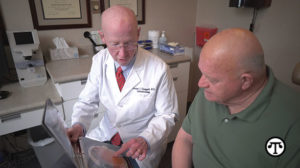Health, Home & Family
 When you are home in lock down you notice things you don’t normally notice. Pictured are some Orchids, yellow and purple, they sit on the kitchen windowsill at home. The flower in the middle is an Amaryllis flower that broke off so we placed between two plants. I thought they were worthy of taking a picture of and sharing. Do you have a picture of a flowering plant you would like to share send it to me? tloury@att.net
When you are home in lock down you notice things you don’t normally notice. Pictured are some Orchids, yellow and purple, they sit on the kitchen windowsill at home. The flower in the middle is an Amaryllis flower that broke off so we placed between two plants. I thought they were worthy of taking a picture of and sharing. Do you have a picture of a flowering plant you would like to share send it to me? tloury@att.net
COVID-19 is a new type of coronavirus; coronaviruses are a large family of viruses, some causing illness in people and others that circulate among animals. Other coronaviruses include the common cold and Severe Acute Respiratory Syndrome (SARS). COVID-19 is believed to have emerged from an animal source and is now capable of spreading from person-to-person. There is currently no vaccine to prevent COVID-19.
The symptoms of COVID-19 can mirror illnesses such as influenza. Patients with COVID-19 typically display symptoms such as fever (100.4°F or higher), cough, and/or shortness of breath within 2 to 14 days of exposure to the virus. Approximately 80% of those affected with COVID-19 report mild to moderate illness and experience a complete recovery. Some experience more severe illness. People who are more vulnerable to the illness include individuals who are over age 65 with underlying health conditions, immunocompromised, ill or have underlying chronic health conditions, such as heart disease or diabetes.
Personal prevention measures are fundamental in preventing the spread of COVID-19 and other respiratory illnesses. The department recommends that individuals:
- Avoid close contact with people who are sick.
- Avoid touching your eyes, nose, and mouth.
- Stay home when you are sick.
- Cover your coughs and sneezes with a tissue, then throw the tissue in the trash.
- Clean and disinfect frequently touched objects and surfaces using a regular household cleaning spray or wipe.
- Wash your hands often with soap and water for at least 20 seconds, especially after going to the bathroom, before eating, and after blowing your nose, coughing, or sneezing.
- If soap and water are not readily available, use an alcohol-based hand sanitizer with at least 60% alcohol.
- Follow CDC’s recommendations for using a facemask.
TALLAHASSEE, Fla. – Today, at Governor DeSantis’ direction, Florida Division of Emergency Management Director Jared Moskowitz issued an Emergency Order temporarily restricting visitation to nursing homes, assisted living facilities (ALFs), adult family-care homes, long-term care facilities and adult group homes.
By restricting visitation, the state is taking proactive measures to limit the potential of COVID-19 entering those facilities. This order has been issued in recognition of the fact that the elderly and those with underlying medical conditions are at higher risk for serious illness from COVID-19. This is also consistent with directions given by the Federal Centers for Medicare and Medicaid Services. Continue reading

Female home caregiver talking with senior woman, sitting in living room and listening to her carefully.
(NAPSI)—Even more than cancer, there’s one disease most people fear. The thought of falling prey to Alzheimer’s disease and to the inevitable desecration of the mind is something that can make even the bravest shudder.
After all, if you’re robbed of your sense of who you really are, you’re doomed to live your last days without the dignity that defines you and that you hold dear. Perhaps the ultimate horror of Alzheimer’s disease is that it is as indiscriminate, merciless, and devastating as a wind-swept wildfire.
As a result, a disease-modifying treatment for Alzheimer’s disease has become a Holy Grail of sorts in the biotech industry. The disease is so ubiquitous, it casts a shadow over just about everyone’s family. At the same time, it exacts a devastating financial toll on society—perhaps even greater than cancer—with Alzheimer’s disease patients needing 24-hour care for an average of eight years and sometimes as many as 20 years.
The estimated cost for caring for Americans with Alzheimer’s disease and other dementias is well in excess of a quarter of a trillion dollars per annum. This doesn’t even include unpaid caregiving. Also, Alzheimer’s disease is ranked as the third leading cause of death of seniors in the United States, surpassed only by heart disease and cancer. Approximately 6 million Americans have become its victims, and this number rises each year as lifespans increase due to advancements in medical science. Continue reading
(NAPSI)—Calls and e-mails from scammers pretending to be government employees are widespread. Social Security phone scams are the #1 scam reported to the Federal Trade Commission. Chances are you, a friend, or a family member have received a call like this.
You don’t have to be receiving benefits to become a victim. You may get a call saying there is a problem with your Social Security number or account. Everyone, regardless of age, income, and geography, is at risk. Scammers will try to scare and trick you into giving them your personal information or money.
Is It A Scam?
The best way to protect yourself and your money is to recognize a scam. Scammers use intimidating language and often offer a “solution” to fix what they say is a serious problem with your Social Security number or account. How can you tell when it’s a scam? Social Security will not: Continue reading
 (NAPSI)—You may have heard the terms—winter blues, Seasonal Affective Disorder (SAD), Depressive Disorder with a Seasonal Pattern. No matter what you call it, with approximately 17.3 million adults in the U.S. experiencing seasonal depression, according to the National Institute of Mental Health, feeling gloomy this time of year isn’t uncommon—but it can be overcome.
(NAPSI)—You may have heard the terms—winter blues, Seasonal Affective Disorder (SAD), Depressive Disorder with a Seasonal Pattern. No matter what you call it, with approximately 17.3 million adults in the U.S. experiencing seasonal depression, according to the National Institute of Mental Health, feeling gloomy this time of year isn’t uncommon—but it can be overcome.
The Problem
Depressive Disorder with a Seasonal Pattern (formerly called SAD) can affect anyone of any age. Whether you’re a student returning to class, a busy working professional who’s always playing catchup, or even newly retired with found time on your hands, the excitement of the holidays is long over and wintry dark days are here. While January and February are the typical peak months for the disorder, symptoms can persist through April, according to Mental Health America. Continue reading
 (NAPSI)—Driving a car means maintaining independence for many older adults. Driving allows you to shop, see friends and family, keep up with medical appointments, and avoid social isolation. But sometimes staying safe behind the wheel as you age can be a challenge.
(NAPSI)—Driving a car means maintaining independence for many older adults. Driving allows you to shop, see friends and family, keep up with medical appointments, and avoid social isolation. But sometimes staying safe behind the wheel as you age can be a challenge.
Age-related physical and mental changes can affect your ability to drive safely. If you’re alert to these changes and manage them carefully, you may be able to continue driving safely for some time.
To keep your skills as sharp as possible, consider following these suggestions from experts at the American Geriatrics Society (AGS), healthcare professionals dedicated to improving the health, independence, and quality of life of older people. Continue reading
 (NAPSI)—Here’s something many parents may be surprised to learn: tooth decay is the most common preventable chronic disease among children in the United States.
(NAPSI)—Here’s something many parents may be surprised to learn: tooth decay is the most common preventable chronic disease among children in the United States.
The Problem
If left untreated, it can hurt more than your kid’s mouth. Your child’s physical and social development—as well as his or her school performance—can also be affected. More than 51 million school hours are lost each year due to dental-related illness. Kids with healthy teeth have fewer sick days and less distractions from learning.
The Good News
Parents may be surprised to find that getting their child’s teeth checked is easier and less expensive than they think. Under Medicaid and the Children’s Health Insurance Program (CHIP), essential health care services like preventative care and dental health are covered. For more than 20 years, CHIP has been instrumental in reducing the number of uninsured children to historic lows. Medicaid and CHIP cover more than one-third of all children in the U.S. and have helped insure 95 percent of the nation’s children—an estimated 35.5 million currently are covered. Continue reading
WOW my taste buds are working over time
Blue Highway Pizzeria
Let’s just make one thing clear: you won’t be blue when your tastebuds thank you for a delicious meal at Blue Highway. Fortunately, I work very close to the location on E. Silver Springs Boulevard and I grab lunch there about twice a month, but my husband’s work commute is about an hour from our home and this nearby treat so it’s literally a treat when he gets to enjoy dinner or a weekend lunch there.
Some of our favorites are their signature Blue Highway salad, complete with toasted pecans, feta, and Kalamata olives, and the Funghi pizza with mushrooms and parmesan and a white cream sauce. Those are two of our staples, but I also recommend their hot tuna panini with a side of herbed Tuscan fries, washed down with a hoppy IPA beer! Literally everything on the menu is delicious and we’ve always had excellent service to make it that much more enjoyable. And don’t forget to sign up for their rewards program, too. It’s a winner for dinner!
RRM
Ivy on the Square
Even if you’re not ravenous, it’s worth a visit to Ivy on the Square in downtown Ocala if only to admire the impeccable décor. It’s as if you walked onto a set at HGTV. But aside from the beautiful ambience, they offer, and deliver, the best old-fashioned, southern comfort food imaginable.
One of my favorite starters is the classic dish of fried green tomatoes. But the tomato caprese salad is nothing to pass up, either. Both are always on point and never disappoint. It’s almost impossible to choose a main course at lunch (or dinner) and I seem to stick to my tried and true Baked Krispy Chicken Salad. I mean, it’s eating healthy, right? A salad? But I have a feeling that the corny cornbread and croissant that’s served with it may not meet today’s keto friendly list of approved dishes, but it’s absolutely worth a cheat day to treat yourself to this.
From salads, to burgers, to wings, to seafood, Ivy on the Square has something for almost everyone. Even picky toddlers will crave their mac & cheese! It’s worth a visit…or several.
RRM
 (NAPSI)—People with low vision have blind spots that can make it difficult or impossible to drive, read or see faces. These impairments cannot be corrected by surgery or glasses. What’s more, too many are blind to the realization that much can be done to improve their quality of life.
(NAPSI)—People with low vision have blind spots that can make it difficult or impossible to drive, read or see faces. These impairments cannot be corrected by surgery or glasses. What’s more, too many are blind to the realization that much can be done to improve their quality of life.
What Can Be Done
In fact, low vision rehabilitation services help people make the most of the vision they have. The first step is to get an eye exam by an ophthalmologist, a physician who specializes in medical and surgical eye care.
Who Can Help
An ophthalmologist can determine the full extent of vision loss and exact location of blind spots. Either the ophthalmologist or a low vision specialist can then determine the best techniques and devices that can help you get around your individual challenges. Continue reading
